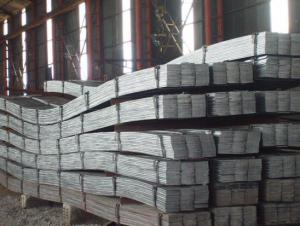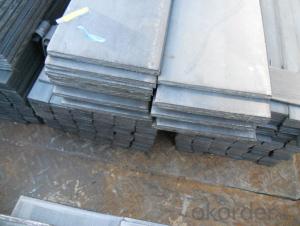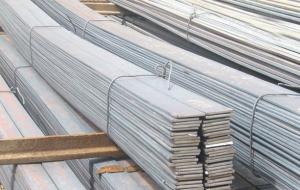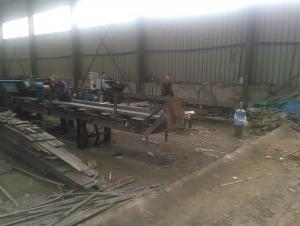Hot Rolled Narrow Flat Steel 20mm*3mm*6m
- Loading Port:
- Tianjin
- Payment Terms:
- TT or LC
- Min Order Qty:
- 25 m.t.
- Supply Capability:
- 10000 m.t./month
OKorder Service Pledge
OKorder Financial Service
You Might Also Like
Product Description:
OKorder is offering Hot Rolled Narrow Flat Steel 20mm*3mm*6m at great prices with worldwide shipping. Our supplier is a world-class manufacturer of steel, with our products utilized the world over. OKorder annually supplies products to European, North American and Asian markets. We provide quotations within 24 hours of receiving an inquiry and guarantee competitive prices.
Product Applications:
Hot Rolled Narrow Flat Steel 20mm*3mm*6m are ideal for structural applications and are widely used in the construction of buildings and bridges, and the manufacturing, petrochemical, and transportation industries.
Product Advantages:
OKorder's Hot Rolled Narrow Flat Steel 20mm*3mm*6m are durable, strong, and resist corrosion.
Product Specifications:
Manufacture: Hot rolled
Grade: Q195 – 235
Certificates: ISO, SGS, BV, CIQ
Length: 6m – 12m, as per customer request
FAQ:
Q1: Why buy Materials & Equipment from OKorder.com?
A1: All products offered byOKorder.com are carefully selected from China's most reliable manufacturing enterprises. Through its ISO certifications, OKorder.com adheres to the highest standards and a commitment to supply chain safety and customer satisfaction.
Q2: How do we guarantee the quality of our products?
A2: We have established an advanced quality management system which conducts strict quality tests at every step, from raw materials to the final product. At the same time, we provide extensive follow-up service assurances as required.
Q3: How soon can we receive the product after purchase?
A3: Within three days of placing an order, we will begin production. The specific shipping date is dependent upon international and government factors, but is typically 7 to 10 workdays.
Q4: What makes stainless steel stainless?
A4: Stainless steel must contain at least 10.5 % chromium. It is this element that reacts with the oxygen in the air to form a complex chrome-oxide surface layer that is invisible but strong enough to prevent further oxygen from "staining" (rusting) the surface. Higher levels of chromium and the addition of other alloying elements such as nickel and molybdenum enhance this surface layer and improve the corrosion resistance of the stainless material.
Q5: Can stainless steel rust?
A5: Stainless does not "rust" as you think of regular steel rusting with a red oxide on the surface that flakes off. If you see red rust it is probably due to some iron particles that have contaminated the surface of the stainless steel and it is these iron particles that are rusting. Look at the source of the rusting and see if you can remove it from the surface.
Images:


- Q: Can steel flat bars be used for making cutting tools?
- Depending on the specific application and the type of steel used, steel flat bars can be utilized in the creation of cutting tools. Steel, being a versatile material, can be hardened and tempered to different levels, making it suitable for a variety of cutting tasks. Nevertheless, it is crucial to select the appropriate type of steel for the desired cutting tool. High-carbon steels, including tool steel or carbon steel, are often the preferred choice as they possess exceptional hardness and resistance to wear. Furthermore, the flat shape of steel bars allows for easy shaping and grinding, enabling the creation of various cutting tool designs like chisels or knives. Proper heat treatment is essential to achieve the desired hardness and toughness in the steel, ensuring optimal performance and long-lasting sharpness of the cutting tool.
- Q: What's the difference between stainless steel flat bar 304 and 316?
- From the metallography point of view, because the stainless steel contains chromium, the surface forms a very thin chromium film, which separates from the oxygen penetrated by the steel.
- Q: Can steel flat bars be used as support beams?
- Yes, steel flat bars can be used as support beams. Steel is known for its strength and durability, which makes it an excellent material for structural support. Steel flat bars are often used in construction and engineering projects to provide support and reinforcement. They can be used as beams to bear heavy loads and distribute weight evenly across a structure. Additionally, steel flat bars can be easily fabricated and cut to desired lengths, making them versatile for various applications. Overall, steel flat bars are a reliable and efficient choice for support beams in construction projects.
- Q: Do steel flat bars have rounded edges or sharp edges?
- Depending on their manufacturing or processing method, steel flat bars can either have rounded edges or sharp edges. Some steel flat bars are made with rounded edges, which are commonly known as "round edge" or "radius edge" bars. These rounded edges offer a smoother and safer surface, reducing the risk of injury from sharp edges. Conversely, some steel flat bars may possess sharp edges, particularly if they were cut or sheared from larger steel pieces. These sharp edges can pose a higher risk of causing injuries if not handled with caution. Hence, it is crucial to examine the specific product description or consult the manufacturer or supplier to determine whether the steel flat bars have rounded or sharp edges.
- Q: Are steel flat bars available in metric sizes?
- Yes, steel flat bars are available in metric sizes.
- Q: Can steel flat bars be used for manufacturing tools or machinery?
- Yes, steel flat bars can be used for manufacturing tools or machinery. Steel is a highly versatile and durable material, making it suitable for a wide range of applications. Steel flat bars are commonly used in the manufacturing industry due to their strength, rigidity, and ability to withstand heavy loads and pressure. They can be easily shaped, welded, and machined to create various components and parts for tools and machinery. Additionally, steel flat bars are known for their excellent resistance to corrosion, which is crucial for ensuring the longevity and reliability of tools and machinery. Overall, steel flat bars are a popular choice in the manufacturing industry for their reliability, versatility, and suitability for producing high-quality tools and machinery.
- Q: What's the difference between hot rolled flat steel and flat rolling tool flat steel?
- Hot rolled flat rolled hot rolled flat steel is a general purpose rectangular cross rolled strip. The specifications are expressed in millimeters of thickness * width, flat steel can be finished steel, used for components, ladders, bridges and fences, etc..
- Q: What are the different types of steel flat bar profiles?
- There are several different types of steel flat bar profiles available, each designed for specific applications and requirements. Some common types include: 1. Mild Steel Flat Bar: This is the most commonly used type of steel flat bar, known for its versatility and affordability. It is often used in construction, manufacturing, and general fabrication projects. 2. Stainless Steel Flat Bar: Stainless steel flat bars are corrosion-resistant and have high strength. They are commonly used in industries such as food processing, chemical, and marine applications where resistance to rust and corrosion is crucial. 3. Alloy Steel Flat Bar: Alloy steel flat bars are made by adding various elements such as chromium, nickel, or molybdenum to enhance their strength, hardness, and durability. They are commonly used in applications where high strength and resistance to wear and tear are required. 4. Tool Steel Flat Bar: Tool steel flat bars are specifically designed for use in cutting tools, mold-making, and other tooling applications. They possess high hardness, wear resistance, and toughness, making them suitable for machining and shaping operations. 5. Carbon Steel Flat Bar: Carbon steel flat bars contain primarily carbon as the main alloying element. They are known for their high tensile strength, excellent weldability, and affordability. Carbon steel flat bars find applications in structural components, machinery parts, and general fabrication. Each of these flat bar profiles has its own unique properties and application-specific advantages. The choice of the right type depends on factors such as the intended use, environmental conditions, and required mechanical properties.
- Q: Are steel flat bars available in non-standard lengths?
- Certainly! Non-standard lengths for steel flat bars are readily available. Although steel flat bars typically come in standard lengths of 20 feet or 6 meters, numerous suppliers offer personalized cutting services to fulfill customers' precise length requirements. This feature enables customers to easily request steel flat bars in non-standard lengths, tailored to the specifications of their particular projects. By granting this versatility, suppliers accommodate a diverse array of demands and guarantee that customers obtain the precise length necessary for their applications.
- Q: Can steel flat bars be drilled or machined?
- Yes, steel flat bars can be drilled or machined. Steel is a versatile material that can be easily drilled or machined to create various shapes and sizes for different applications.
Send your message to us
Hot Rolled Narrow Flat Steel 20mm*3mm*6m
- Loading Port:
- Tianjin
- Payment Terms:
- TT or LC
- Min Order Qty:
- 25 m.t.
- Supply Capability:
- 10000 m.t./month
OKorder Service Pledge
OKorder Financial Service
Similar products
Hot products
Hot Searches
Related keywords




























